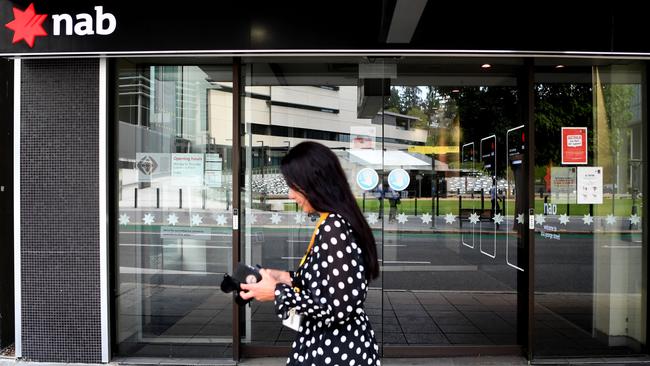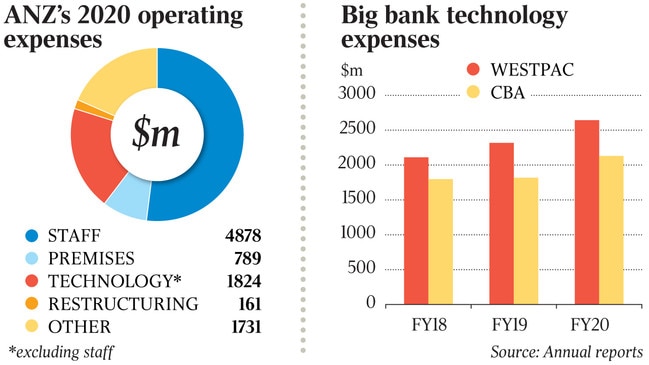Banks, corporates learn a lesson from Google and Facebook about the power of data
The banking industry is building up real-time insights into customer behaviour that were unimaginable only five years ago.

When ANZ boss Shayne Elliott recently likened the benefits of big-data analytics to the critical task of contact tracing in the COVID-19 pandemic, the banking industry’s data wonks silently thanked him for some long-overdue recognition.
Sure, there is a gaping chasm between the ability of legacy banks and the likes of Google and Facebook to monetise their never-ending torrents of customer data.
However, after the distraction of the financial services royal commission, Elliott and his peers have started to showcase the rewards from past investment; namely, real-time insights into customer behaviour that were unimaginable only five years ago.
“We’re literally able to see in real-time how people are behaving — what they’re spending, where they’re spending, we can see it at postcode level, we can see it by industry segments, and of course we can see it at a customer level,” the ANZ chief said at the bank’s full-year result.
“And so we have the ability to really understand what’s going on with this particular small business or this particular homeowner and determine what’s right for them — it’s a massive capability and it’s going to prove to be a real advantage for us in terms of helping the community.
“In many ways it’s our equivalent of contract tracing.” When The Weekend Australian asked National Australia Bank for some updated figures on post-lockdown activity levels in Victoria, an executive tapped the bank’s algorithms – and its resident data scientist — and came back with the answers. Pronto.
In the two weeks since lockdown ended, spending in the state’s general retail stores was up 18 per cent on a year ago, with department stores 109 per cent higher, hardware up 69 per cent, and electronic goods up 66 per cent.
Health expenditure spiked, as well, as customers took a renewed interest in dental hygiene and repair (up 33 per cent), and their eyesight (optometrists up 32 per cent).
The performance of the broader state economy is also picking up.
Total spending in the week of November 4-10 was up 10 per cent, or $43m, compared to the week before, and 6 per cent higher than a year ago.
The data, which is sourced from merchant terminals, gives NAB real-time insights into the time, location, category, size of the spend and multiple transactions sorted by individual customers.
By itself, this isn’t a new capability. However, enhanced use of data and analytics is one of chief executive Ross McEwan’s 19 “mission-critical” investment projects, which he downsized from more than 100 soon after joining the bank.
In March 2021, NAB will launch Pollinate, giving small and medium-sized businesses immediate access to insights and general activity levels.
The numbers crunched by NAB are but one tiny segment of the explosive, overall growth in the volume of global data.
Estimates from 2016 suggest that 90 per cent of global information was created in the previous two years, with the avalanche sourced from social media posts and emails, mobile devices, and physical objects embedded with sensors — the so-called Internet of Things.
With the advent of cloud computing, the cost of data storage has tumbled, as well, and at the other end of the chain increasingly sophisticated analytics has enhanced the ability to identify valuable patterns and correlations.
These are the building blocks of a nascent data economy, involving trade in data between organisations and/or governments, and the products, such as algorithms, insights and applications, that arise from previously unobtainable data.
While the parameters are imprecise, management consultancy McKinsey & Co has estimated that open data is generating more than $3 trillion in annual economic value across a range of sectors, from healthcare to transportation to consumer finance.
In these sectors, data and the provision of digital services are closely related — data enables the production of digital products and services, but it can also be an output from the use of such products and services.
Examples include the online consumer behemoths Amazon, Netflix and Uber, which have caused mayhem and disruption to the industries they have entered over the last 20 or so years.
Locally, and on a much smaller scale, there are companies like Kepler Analytics, which uses sensors in bricks and mortar retail stores to determine foot traffic through the density of mobile signals.
Co-founder David Gordon stresses that the sensors only pick up aggregated data, but it’s 95 per cent effective in forecasting sales.
“The truth is there’s no shortage of data in the world, but for us the real question is what is the most effective use of it to deliver a better shopping experience and a better sales outcome,” Gordon says.
Even the stodgy financial sector, which has often been highly resistant to change, is hosting a wave of innovation, driven by digital technology and the use of new and existing forms of data.

Two main benefits have emerged from the bustling data economy, according to the Productivity Commission.
They are more effective and better-informed decision-making, leading to efficiency gains and productivity growth, and greater insights and knowledge to better understand health, human behaviour and natural phenomena.
COVID-19 is a good example, with the Australian Bureau of Statistics using anonymised major-bank transaction data to help inform official ABS estimates of sales by businesses, household consumption and gross domestic product.
The ABS was concerned about statistical distortions, and misdirected government policies, due to small sample sizes from many businesses going into hibernation.
“For us, the major banks were an important data source — they gave us a lot of confidence in our surveys,” ABS chief data officer Marcel van Kints says.
“We’re not competing with the banks; we’re trying to generate public value by ensuring the best statistics are used.
“It’s been a very useful exercise. Our ambition is to make it a permanent arrangement.”
As a former deputy chair of the Productivity Commission, which completed its landmark report on data availability and use in 2017, acting ASIC chair Karen Chester is unsurprisingly a data devotee, telling a business conference on Wednesday that it informed the conduct regulator’s judgment calls on its post-royal commission “Why not litigate?” approach to enforcement.
The threshold requirement was evidence for a breach of the law, but ASIC also had to determine if there was “regulatory value” in pursuing the matter.
Data, according to Chester, was key to ASIC coming to grips with the real economic impact of its regulatory decisions; hence the new systems to exploit existing data and lay the foundations for improved analytics.
“These systems use modern technology and advanced analytics to analyse and detect early warning signs of harm and unhealthy competition in markets, because where unhealthy competition exists you are more likely to find a greater opportunity and thus propensity for misconduct and ultimately harm,” she said. “The value-add to our calibrated regulatory stance cannot be overstated, but we need to go further.
“Parts of the playing field are data-poor — for example, recurrent data for investment management and data for small-amount credit contracts, which are areas where we do not have specific data collection powers afforded to us by the parliament.
“We are working with Treasury to ensure we have — and can publicly share — much greater data on retail management investment products, wholesale funds and non-bank lending.”
No one doubts there is a big prize available for the country which is best able to exploit the data opportunity.

The big question, though, is how to navigate the perceived trade-off between privacy and innovation.
Danny Gilligan, co-founder of the Data Republic platform for secure data collaboration between companies, is a strong supporter of the balanced approach and open data policy adopted by Australia.
At the other end of the spectrum, according to Gilligan, is the US, which might be able to boast of the world’s most developed data economy but it’s concentrated in the hands of a select few: Facebook and Google.
“The US has consistently operated in more of a ‘grey market’ in trade of data — stated privacy principles are not well understood or consistently enforced,” he says.
“It’s a highly fragmented transactional data market which serves the interests of the tech giants and makes broader development challenging.”
In simple terms, an immense amount of data goes into the Google and Facebook machines but very little ever comes out. They’re in business to monetise data.
The Australian model, informed by King & Wood Mallesons partner Scott Farrell’s review into open banking, is very different.
The government has acted on Farrell’s recommendation to legislate for a consumer data right, giving customers the right to share their data only with trusted recipients for authorised purposes.
The right has been implemented initially in banking through the open banking initiative but will proceed to the energy and telecommunications sectors and then cover the entire economy, sector by sector.
The overriding objective is to build strong safeguards so that competition for our data is fair.
A stable market is seen to be in the interests of everyone, not just the really clever or the super-rich.
Gilligan reckons it’s a much more considered view of the data economy, with the consumer data right and open data policy helping to balance the privacy and innovation equation.
“And the fascinating thing is that the data with the Australian banks, telcos and insurers is collectively far more useful,” he says. “It’s hard to work with and isn’t open yet for innovation, but its latent value is worth a lot more — Google, for example, won’t know how many chickens I’ve bought or where I bought them.”
Gilligan also strongly endorses Treasury taking oversight of the consumer data right from the Australian Competition & Consumer Commission.
The move, announced in October, confirms the importance of what’s now regarded as the government’s flagship competition policy.
For Gilligan, it has the potential to mirror the best-practice structure in Singapore, with a single government agency responsible for both the development of the data economy as well as privacy.
At the end of last month, Farrell handed over a new report to Treasury on future directions for the consumer data right.
While he won’t discuss the contents, an issues paper suggests it will examine the addition of so-called “write access” to the consumer data right, so customers could direct a trusted third party to change or add to their data.
Farrell will also look at the switching process to make it easier for customers to choose a new service provider.
“We have a data sector because we share so much,” Farrell tells The Weekend Australian.
“Ordinary businesses like airlines and retailers are already part of it, but every business should be able to participate so we can use it in our everyday lives.”



To join the conversation, please log in. Don't have an account? Register
Join the conversation, you are commenting as Logout